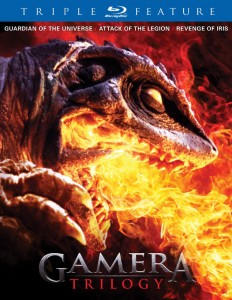Director: Shusuke Kaneko
Cast: Shinobu Nakayama, Ayako Fujitani, Yukijiro Hotaru, Ai Maeda, Toshiyuki Nagashima
Running Time: 100/100/108 min.
By HKFanatic
In the mid-90’s, director Shusuke Kaneko (later responsible for the live-action “Death Note” films) was tasked with rebooting the “Gamera” franchise. Gamera originally appeared in the 1960’s as a giant monster, or kaiju, to rival Godzilla: a space turtle who was known as “The Friend of All Children.” Although Gamera caused plenty of destruction in his 1965 debut film, there wasn’t much in the original, kid-friendly series to suggest the dark direction Kaneko would take with his trilogy, starting with 1995’s “Gamera: Guardian of the Universe.”
Kaneko had the brilliant idea of revamping Gamera as a remnant of the lost civilization of Atlantis; this time the turtle is a massive bio-weapon built to defend the earth against future threats. In “Guardian of the Universe” that threat is the Gyaos, a bird-like species also constructed by Atlantis to keep the planet’s population in check. When man begins wrecking the environment and altering the surface world with carbon emissions and such, the Gyaos hatch from their slumber and take flight. Only Gamera can save us, adding a timely environmental message to the entire trilogy that especially rings true in light of Japan’s current nuclear anxieties.
To be honest, I’ve only seen a handful of giant monster movies, mostly from the “Godzilla” franchise, but I can’t imagine a kaiju film being much better than “Guardian of the Universe.” The movie moves a good clip, contains innovative camera angles and snappy colors, and the monster costumes and model cities are incredibly detailed. The final battle takes place during daylight hours so we witness Gamera and Gyaos going at it in all their glory. This includes an amazing POV shot from Gamera’s perspective as he soars down the streets of Tokyo, a cinematic flair that would make Sam Raimi jealous. The ending even made me want to tear up a little, especially when the composer lifted a motif from John Williams’ “Jurassic Park” score for maximum emotional impact. This “Gamera” has everything I could want from a film about two monsters duking it out over Tokyo.
“Gamera 2: Attack of Legion,” released a year later in 1996, registers as something of a disappointment. It’s entertaining enough for a kaiju flick but the main problem is that Gamera himself is missing in action for most of the film’s runtime. The extraterrestrial threat of Legion isn’t all that threatening either; the bug-like monster looks like something Casper Van Dien would have wiped off the bottom of his shoe while filming “Starship Troopers.” Legion is not exactly the coolest foe for Gamera to be fighting and the script plays into the kaiju movie cliche of laboriously following human characters and the military, only giving the monsters their due screentime at the end. The fact that Legion in no way ties into Gamera’s Atlantean origins also detracts from what made the first film so unique.
Released three years later in 1999, “Gamera 3: Revenge of Iris” rectifies this by bringing the story full circle. The Gyaos are back as well as a Gyaos mutation known as Iris, who instead of merely controlling the population is designed to wipe us out and and restart civilization. Iris is controlled mentally by a young girl whose parents were collateral damage in Gamera’s original battle with the Gyaos. As you can probably tell from this synopsis, “Gamera 3” is much darker than the previous films and this is even reflected in the costume for Gamera, who appears spikier and more menacing than he did before. Some fans will no doubt appreciate this ‘adult’ take on the kaiju genre but altogether I found the plot too depressing and cryptic for its own good, with the final battle descending into a bloody mess of severed limbs and tentacles.
Unfortunately, the subtitles on Mill Creek Entertainment’s blu-ray release of “Gamera 3” don’t make the impenetrable story any easier to follow; there are times when the subtitles seem to skip over entire sentences, giving one the feeling that they’re missing out on key dialogue exchanges. This is especially true during the climax of the film when several characters – including a nihilistic video game developer and a girl who can hear Gamera’s thoughts – are standing around a train station. Halfway through this scene, I realized I couldn’t tell you why these characters were together or how they felt about each other. Part of it is the subtitles, part of it is the script. A quick trip to the IMDB message boards will shed some light on “Gamera 3’s” plot but it begs the question: do I really want to watch a movie about men in rubber suits that’s so dense I need a crib sheet just to understand the story?
ADV Films originally released the Gamera Trilogy on DVD way back in 2003. Once ADV became defunct, Mill Creek Entertainment obtained the rights. To the delight of fans, Mill Creek has decided to release the trilogy on blu-ray in an extremely affordable package. The presentation of these films is close to perfect but just misses the mark in a few ways. The transfer on “Gamera: Guardian of the Universe” looks fantastic but onscreen text like newspaper headlines and subway flyers are not translated by the subtitles. “Gamera 2’s” picture appears a bit softer but it rectifies the mistake of not translating headlines. “Gamera 3,” being the most recent film, looks superb in terms of visual quality but, as I mentioned, the subtitles are severely flawed, skipping over entire sentences at times. Although it’s understandable if hardcore fans are disappointed by such flubs, if one can overlook these few flaws then the “Gamera Trilogy” is undoubtedly a great package and a must purchase for kaiju fans.
HKFanatic’s Rating: 9/10



